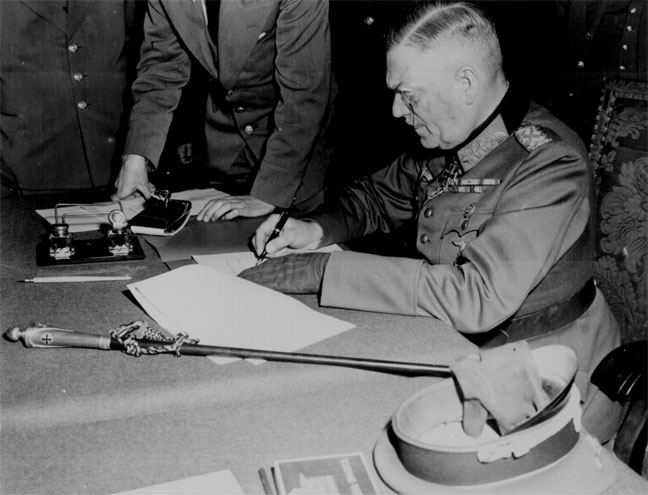MAY 8th 1945 Germany Surrenders

Field Marshall Wilhelm Keitel, signing the ratified surrender terms for the German Army at Russian Headquarters in Berlin
On May 8th, German forces officially surrendered. Signing for the Germans was Chief of Staff General Jodl. The surrender ceremony took place at Eisenhower's headquarters at Reims on May 7th A second ceremony took place on May 8th in Berlin.
After Hitler’s suicide Admiral Karl Donita became the Head of State. Although Berlin had fallen, there were 100,000’s of German troops in the field still fighting. German forces in Italy and Western Austria surrendered on April 29th which came in effect on May 2nd. German forces in Northwest Germany, Netherlands, Denmark and Schleswig-Holstain surreded on May 4th. On May 5th German forces in Bavaria and southern Germany surrendered to American forces at Haar. The Germans were attempting to arrange for as many troops as possible to the Americans instead of the Soviets. By May 5th the Germans had stopped fighting on the western front, but were still fighting the Soviets. The Americans realized that if they did not bring an end to the fighting the Soviets would believe that the Americans were agreeing to a seperate peace. They told the Germans to send representatives to Reims to negotiate a total surrender.
General Jodl was sent to Reims on May 6th and wanted to negotiate, but General Eisenhower said that if the Germans did not surrender by 9PM the US would resume attacking German troops and cities. Jodl agreed the surrender which was to take effect on May 8 one hour after midnight. Signing for the Americans was General Bedell Smith and for the Soviets was Ivan Susloparov. The Soviets insisted that the Germans sign again in Berlin, this time with representatives of all parts of the German military.
The following was the signed text:
ACT OF MILITARY SURRENDER
1)We the undersigned, acting by authority of the German High Command, hereby surrender unconditionally to the Supreme Commander, Allied Expeditionary Force and simultaneously to the Supreme High Command of the Red Army all forces on land, at sea, and in the air who are at this date under German control.
2)The German High Command will at once issue orders to all German military, naval and air authorities and to all forces under German control to cease active operations at 23.01 hours Central European time on 8 May 1945, to remain in all positions occupied at that time and to disarm completely, handing over their weapons and equipment to the local allied commanders or officers designated by Representatives of the Allied Supreme Commands. No ship, vessel, or aircraft is to be scuttled, or any damage done to their hull, machinery or equipment, and also to machines of all kinds, armament, apparatus, and all the technical means of prosecution of war in general.
3) German High Command will at once issue to the appropriate commanders, and ensure the carrying out of any further orders issued by the Supreme Commander, Allied Expeditionary Force and by the Supreme Command of the Red Army.
4)This act of military surrender is without prejudice to, and will be superseded by any general instrument of surrender imposed by, or on behalf of the United Nations and applicable to GERMANY and the German armed forces as a whole.
5)In the event of the German High Command or any of the forces under their control failing to act in accordance with this Act of Surrender, the Supreme Commander, Allied Expeditionary Force and the Supreme High Command of the Red Army will take such punitive or other action as they deem appropriate.
6)This Act is drawn up in the English, Russian and German languages. The English and Russian are the only authentic texts.
Representatives:
Soviet Union: Marshal Georgy Zhukov on behalf of the Supreme High Command of the Red Army
United Kingdom: Air Chief Marshal Sir Arthur William Tedder, as Deputy Supreme Commander of the Allied Expeditionary Force,
United States: General Carl Spaatz, Commanding United States Strategic Air Forces, as witness
France: General Jean de Lattre de Tassigny, Commanding First French Army, as witness
Germany:
Field Marshal Wilhelm Keitel as the Chief of the General Staff of the German Armed Forces (Oberkommando der Wehrmacht) and as representative of the army (Heer)
General-Admiral Hans-Georg von Friedeburg as Commander-in-Chief of the navy (Kriegsmarine)
Colonel-General Hans-Jürgen Stumpff as the representative of the air force (Luftwaffe)
 >
>